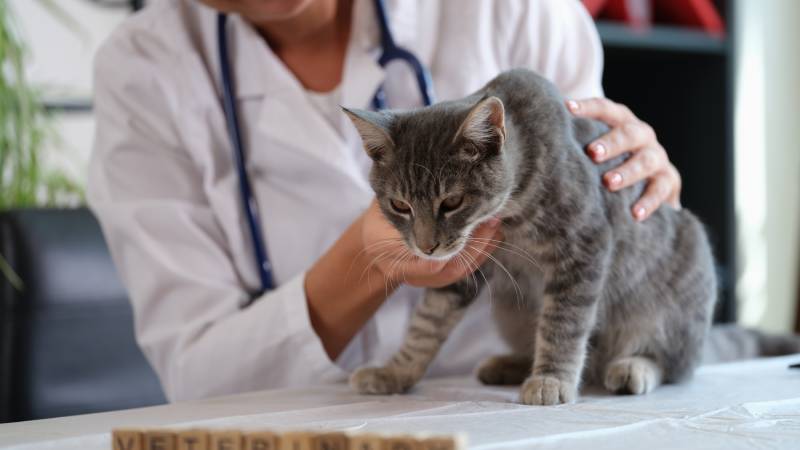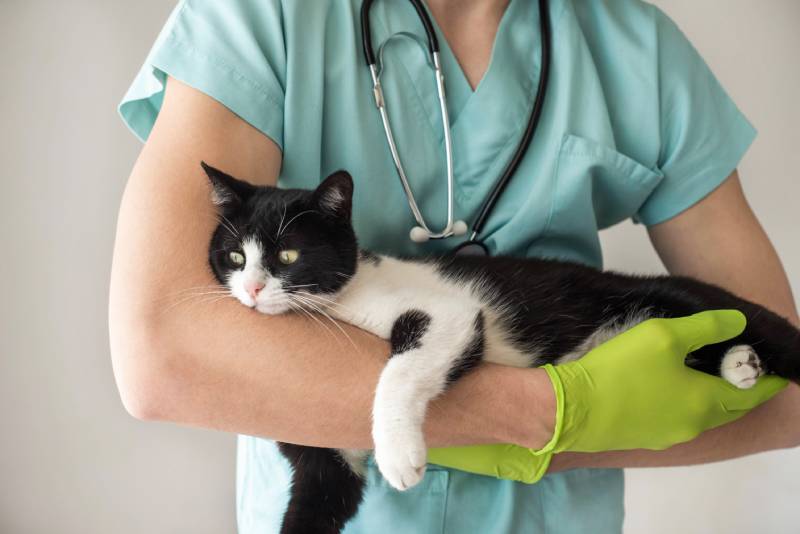VET APPROVED

The information is current and up-to-date in accordance with the latest veterinarian research.
Learn more »Unfortunately, cancer impacts cats frequently. Over 65% of all bone tumors occurring in cats are osteosarcomas, although bone tumors as a whole are uncommon.1 Osteosarcomas can cause significant pain and discomfort in our feline companions. Continue reading to learn more about this malignant illness in cats.

What Is Osteosarcoma?
Osteosarcoma is a malignant form of bone cancer. It is the most common form of bone cancer in both dogs and cats, although osteosarcomas in cats tend to be less aggressive than in dogs. The cancer occurs secondary to the abnormal production of cells responsible for the production (osteoblast) and destruction (osteoclast) of bone.
Cats suffering from osteosarcomas experience breakdown of the bone and can very rarely have local metastasis. Metastasis is the term used to describe the spread of cancer from one place in the body to another and occurs in a low percentage of osteosarcoma cat patients.

What Are the Signs of Osteosarcomas in Cats?
- Pain on palpation of impacted bone
- Mobility changes
- Muscle wasting
- Reduced appetite
- Lethargy
- Visible swelling
- Lymph node enlargement
If you’re concerned about your pet’s well-being, we recommend you contact a veterinarian.
Where Does Osteosarcoma Occur in the Body?
Osteosarcomas generally occur within bones; however, they can occur in soft tissue as well. When osteosarcomas impact soft tissues, they are called extraskeletal osteosarcomas. More common are appendicular osteosarcomas, where the cancer impacts the limbs. The bones most commonly affected by this type of cancer are the femur and tibia. Axial osteosarcoma describes bone cancer occurring in bones not associated with limbs, like the spine and jaw.
How Is Osteosarcoma Diagnosed in Cats?
If you notice signs of lameness in your cat or notice swelling of a limb, an appointment should be scheduled with your veterinarian. Your veterinarian will perform a complete physical exam and will pay special attention to the area of concern.
Once the physical examination is complete, radiographs will likely be recommended. Radiographs will illustrate changes to the bone that can be suggestive of cancer. Bones impacted with cancer will often appear lytic or “moth-eaten.” This means the density of the bone is altered due to destruction. If the bone becomes weak enough, pathologic fractures may occur. Radiographs of the chest and abdomen will also be recommended to check for signs of metastasis.
A bone biopsy may be beneficial to identify cells making up the tumor. This is typically done under anesthesia and involves removing a portion of the lesion for evaluation under the microscope. Alternatively, if suspected to be aggressive, the limb with the tumor may be amputated and biopsied.
In some cases, advanced imaging may be necessary to survey bone involvement.

How Is Osteosarcoma Treated in Cats?
Treatment for osteosarcoma can vary based on the patient. Depending on where the tumor is located, surgical removal of the cancer is recommended, which may result in limb amputation. Surgical removal of the tumor is often all that is needed in cats as metastasis is rare.
In patients with inoperable tumors or tumors unable to be completely removed due to location, chemotherapy and radiation may be helpful. Palliative care focused on pain relief is necessary.

How Do I Care for a Cat With Osteosarcoma?
1. Monitoring
When caring for a cat with osteosarcoma, it is important to develop a relationship with your veterinarian. Your cat should be closely monitored for signs of worsening of their clinical signs, including lameness and discomfort. Your veterinarian may recommend a consultation with a veterinary oncologist for surgery and to discuss treatment options and prognosis.
It is recommended that cats with osteosarcomas have a physical examination and radiographs performed every 3 months for the first year after diagnosis to monitor for metastasis. After the initial year, the length between radiographs can be increased to every 4–6 months.

2. Pain Control and Supportive Therapy
The most important aspect of caring for your cat is adequate pain control. This can be achieved through NSAIDS, opioids, and other medications, like gabapentin. Some patients may find relief from signs with radiation therapy.
Cats suffering from cancer may experience a reduced appetite, so supportive therapies like appetite stimulants may be necessary.
3. Lifestyle Adjustments
If surgical removal has been done of the mass which resulted in limb amputation, adjusting your cat’s lifestyle may be necessary. Owners may consider temporarily relocating food, water, and litter box locations to help with ease of access. Outdoor cats with a limb amputation may be safer becoming indoor pets.

4. Prognosis of Patients With Osteosarcoma
Cats that are able to have surgical removal of the cancer have a survival time of 4 years. Patients who are treated with radiation and chemotherapy can have 6–12 months of survival, depending on whether axial or appendicular in nature.

Frequently Asked Questions (FAQ)
Is Chemotherapy Necessary for All Cats With Osteosarcoma?
Fortunately, no. Due to the low chance of metastasis, chemotherapy is not always needed. However, it may be recommended if surgery is not possible.
Is Osteosarcoma Painful?
Yes, unfortunately, bone cancer is very painful. The focus of osteosarcoma treatment is pain management, as patients with inadequate pain control have a poor quality of life.


Summing Up
Osteosarcomas in cats are highly aggressive, malignant tumors. It is important to discuss treatment options with your vet and work closely to ensure that your pet remains as comfortable as possible. Unfortunately, cats with osteosarcomas will likely succumb to their illness within 12 months of diagnosis if surgical excision is not possible.
Featured Image Credit: R. Hutch Photography, Shutterstock













2 Responses
I am waiting on a biopsy result for my cat but I’m fairly certain it’s Osteosarcoma. The areas weeps and drains all the time and she will not quit licking it. Is it OK to cover the tumor with a telfa non-stick gauze and wrap it with coban wrap to help control the drainage/bleeding? I can’t keep washing everything every day from the problem. Thank you very much.
Hi Cynthia,
thank you for reading us. With tumors and malignancies, even experienced vets rely on the cytology or histopathology test for diagnosis. We can not know what kind of tumor is without these tests.
It is not recommended that you try to bandage your cat by yourself, as you could unintentionally hurt your cat.
The idea of protecting a bleeding and oozing lesion is good but our advice is you take the cat to the vet so they can evaluate the lesion and provide proper treatment along with the necessary care recommendations to avoid secondary infections and complications.
You can also book an video call appointment with one of our vets at PangoVet.com. They will be happy to help you and answer all your questions.